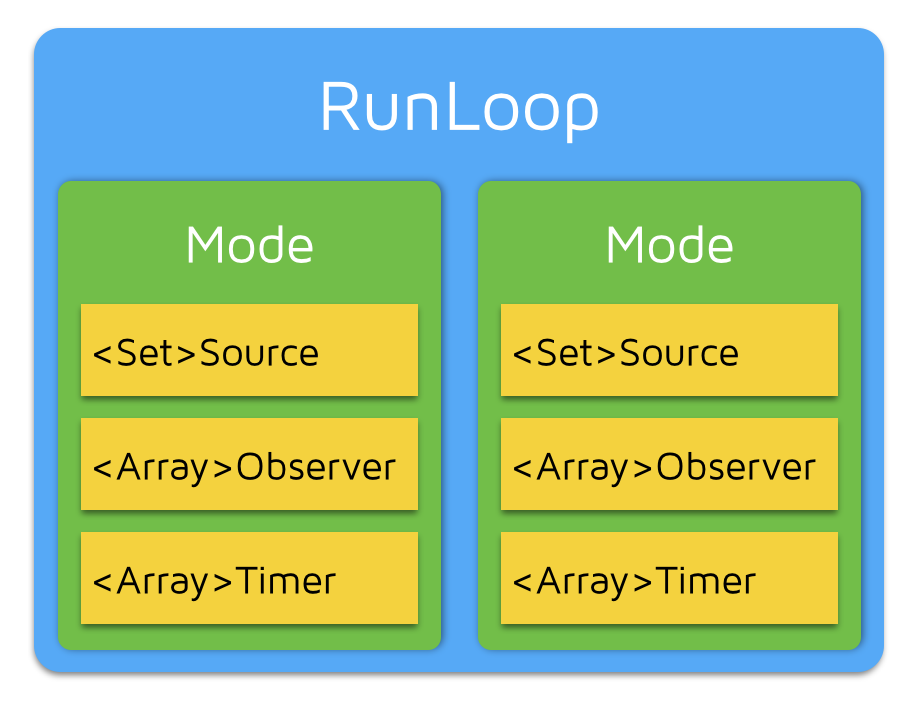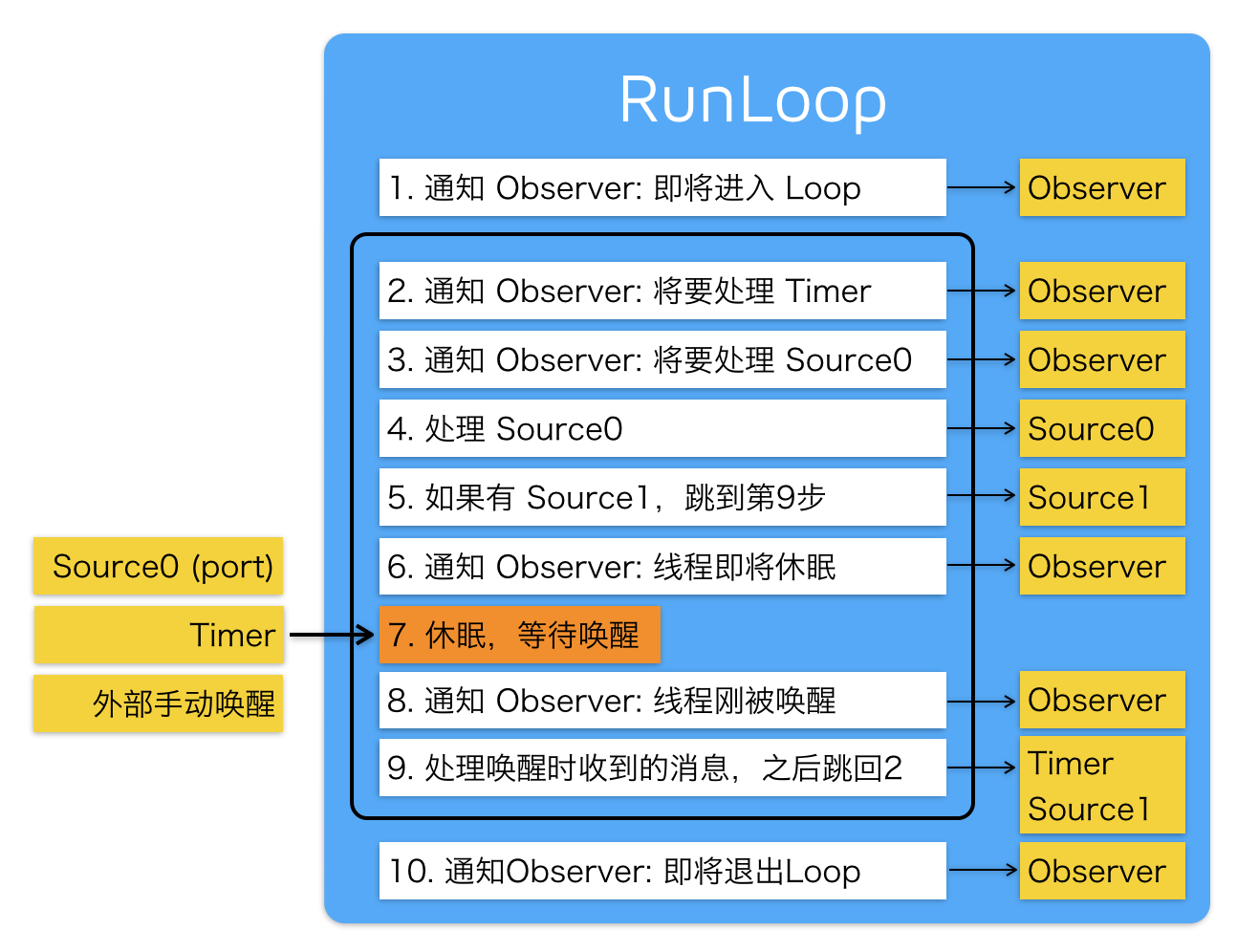iOS的Runloop认知
概念
RunLoop是iOS和OS X开发中非常基础的知识,通过RunLoop可以实现自动释放池,延迟回调,触摸事件,屏幕刷新等功能。
一般来讲,一个线程一次只能执行一个任务,执行完成后线程就会退出。如果我们需要一个机制,让线程能随时处理事件但并不退出,通常的代码如下:1
2
3
4
5
6
7function loop() {
initialize();
do {
var message = get_next_message();
process_message(message);
} while (message != quit);
}
这种模型通常被称作 Event Loop。 Event Loop 在很多系统和框架都有实现,比如Node.js的事件处理,比如Windows程序消息循环,再比如iOS/OS X里的RunLoop.
实现这种模型的关键点在于:如何管理事件/消息,如何让线程在没有处理消息时休眠以避免资源占用、在有消息来到时立刻被唤醒。
所以 RunLoop 实际上就是一个对象,这个对象管理了其需要处理的事件和消息,并提供了一个入口函数来执行上面的 Event Loop 的逻辑。线程执行了这个函数后,就会一直处于这个函数内部 “接收消息 -> 等待 -> 处理” 的循环中,知道这个循环结束(比如传入quit的消息),函数返回。
在iOS/OS X系统中,提供了两个这样的对象:NSRunLoop和CFRunLoopRef。CFRunLoopRef是在CoreFoundation框内的,提供了纯C函数的API,代码是开源的,所有这些API都是线程安全的。NSRunLoop是基于CFRunLoopRef的封装,提供了面向对象的API,但是这些API不是线程安全的。
Swift开源后,苹果又维护了一个跨平台的CoreFoundation版本:https://github.com/apple/swift-corelibs-foundation/ 这个版本的源码可能和现有的iOS系统中的实现略有不同,但是更容易编译,因为它已经适配了 Linux/Windows
RunLoop对外的接口
在CoreFoundation里面关于RunLoop有5个类
- CFRunLoopRef
- CFRunLoopModeRef
- CFRunLoopSourceRef
- CFRunLoopTimerRef
- CFRunLoopObserverRef
其中 CFRunLoopModeRef 类并没有对外暴露,只是通过 CFRunLoopRef 的接口进行了封装。他们的关系如下:
- 一个RunLoop包含若干个Mode
每个Mode包含若干个Source/Timer/Observer每次调用RunLoop的主函数时,只能指定其中一个Mode,这个Mode被称作CurrentMode- 如果需要切换Mode,只能先
退出Loop,再重新指定一个Mode进入 - 这样做的
目的是为了分割开不同组的Source/Timer/Observer
CFRunLoopSourceRef 是事件产生的地方。Source有两个版本:Source0和Source1。
Source0包含了一个回调(函数指针),不会主动出发事件。使用时,需要先调用CFRunLoopSourceSignal(source)将这个Source标记为待处理,然后手动调用CFRunLoopWakeUp(runloop)来唤醒RunLoop,让其处理这个事件。Source1包含了一个mach_port和一个回调(函数指针),被用于通过内核和其他线程互相发送消息。这种Source能主动唤醒RunLoop的线程。
CFRunLoopTimerRef 是基于时间的触发器,它和NSTimer是toll-free bridged(也就是互相可替换)的,可以混用;它包含了一个时间长度和一个回调;当其被加入到RunLoop时,RunLoop会注册对应的时间点,当达到时间点时,RunLoop会被环形以执行那个回调
CFRunLoopObserverRef 是观察者,每一个Observer都有一个回调(函数指针),当RunLoop状态发生变化时,观察者就能通过回调接受到这个变化,观测的时间点有:1
2
3
4
5
6
7
8typedef CF_OPTIONS(CFOptionFlags, CFRunLoopActivity) {
kCFRunLoopEntry = (1UL << 0), // 即将进入Loop
kCFRunLoopBeforeTimers = (1UL << 1), // 即将处理 Timer
kCFRunLoopBeforeSources = (1UL << 2), // 即将处理 Source
kCFRunLoopBeforeWaiting = (1UL << 5), // 即将进入休眠
kCFRunLoopAfterWaiting = (1UL << 6), // 刚从休眠中唤醒
kCFRunLoopExit = (1UL << 7), // 即将退出Loop
};
RunLoop的Mode
CFRunLoopMode结构如下1
2
3
4
5
6
7
8struct __CFRunLoopMode {
CFStringRef _name; // Mode Name, 例如 @"kCFRunLoopDefaultMode"
CFMutableSetRef _sources0; // Set
CFMutableSetRef _sources1; // Set
CFMutableArrayRef _observers; // Array
CFMutableArrayRef _timers; // Array
...
};
CFRunLoop结构如下1
2
3
4
5
6
7struct __CFRunLoop {
CFMutableSetRef _commonModes; // Set
CFMutableSetRef _commonModeItems; // Set<Source/Observer/Timer>
CFRunLoopModeRef _currentMode; // Current Runloop Mode
CFMutableSetRef _modes; // Set
...
};
苹果公开的Mode有两个,这两个Mode都是被标记为common属性,如下:
- kCFRunLoopDefaultMode(UIDefaultRunLoopMode)
- UITrackingRunLoopmode
应用场景举例:
主线程的RunLoop的UIDefaultRunLoopMode是App平时所处的状态,UITrackingRunLoopmode是追踪ScrollView滑动时的状态。当你创建一个Timer并加入到DefaultMode时,Timer会得到重复回调,但是此时滑动一个TableView时,RunLoop会将Mode切换为TrackingRunLoopMode,这时Timer就不会被回调,并且也不会影响滑动操作。
可是有时你需要一个Timer,在两个mode中都能得到回调,办法有两种;
- 1.将这个
Timer分别加入到两个Mode中去 - 2.将
Timer加入到顶层的RunLoop的commonMode
RunLoop的内部逻辑
根据苹果文档里的说明,RunLoop内部的大概逻辑如下:
具体看这里
苹果用RunLoop实现的功能
首先我们来了解下App启动后的RunLoop的状态,分别向系统注册了5个mode:
- 1.kCFRunLoopDefaultMode,App的默认mode,通常主线程在这个mode下运行的
- 2.UITrackingRunLoopMode,界面跟踪mode,用于UIScrollView追踪触摸滑动时保证界面不受其他mode影响
- 3.UIInitializationRunLoopMode,在App刚启动时第一个进入的Mode,启动完后便不再使用
- 4.GSEventReceiveRunLoopMode,接受系统事件的内部mode,通常用不到
- 5.kCFRunLoopCommonModes,这是一个占位mode,没有实际作用
定时器 NSTimer其实就是CFRunLoopTimerRef,他们之间是toll-free bridged(互相替换)。一个NSTimer注册到RunLoop后,Runloop会为其重新的时间点注册好事件。
例如:10:00, 10:10, 10:20 这个几个时间点。RunLoop为了节省资源,并不会在非常准确的时间点回调这个Timer。Timer有个属性叫做Tolerance(宽容度),表示当时间点到达后,容许有多少的误差。如果某一个时间点错过了,例如执行了一个很长时间的任务,则那个时间点的回调会被跳过去,不会延后执行
CADisplayLink是一个和屏幕刷新率一致的定时器(但实际实现原理更为复杂,和NSTimer并不一样)。如果在两次屏幕刷新之间执行了一个任务,那其中就会有一帧会被跳过去(和NSTimer一样),这就造成了界面卡顿的感觉。尤其是在快速滑动tableView时,即时有一帧的卡顿也会让用户有所察觉。Facebook开源了AsyncDisplayLink(现在改名了叫做Texture)就是为了解决界面卡顿的问题,其内部也用到了RunLoop。
PerformSelector
当调用NSObject的performSelector:afterDelay:后,实际上是在其内部创建了一个Timer并且加入到当前的线程的RunLoop中,所以如果当前线程中没有RunLoop,则这个方法会失效
当调用performSelector:onThread:时,实际上也会创建一个Timer加到对应的线程中去,同样的,如果对应的线程中没有RunLoop,则该方法也会失效
以上的内容摘自:https://blog.ibireme.com/2015/05/18/runloop/
看例子
第一个例子,让一个线程常驻1
2
3
4
5
6
7
8
9
10
11
12
13
14
15
16
17
18
19
20
21
22
23
24
25
26
27
28
29
30
31
32
33
34
35
36
37
38
39
40
41
42
43
44
45
46
47- (void)viewDidLoad {
[super viewDidLoad];
NSLog(@"1.创建线程");
self.alwasyThread = [[NSThread alloc] initWithTarget:self selector:@selector(alwaysRun) object:nil];
NSLog(@"2.启动线程,包括:1).线程进入就绪状态;2).线程获得CPU资源后运行状态");
[self.alwasyThread start];
}
- (void)alwaysRun {
NSLog(@"该线程一直在活跃 %@", [NSThread currentThread]);
self.runloop = [NSRunLoop currentRunLoop];
[self.runloop addPort:[NSPort port] forMode:NSDefaultRunLoopMode];
[self.runloop run];
NSLog(@"不会执行到这里");
}
- (void)touchesBegan:(NSSet<UITouch *> *)touches withEvent:(UIEvent *)event
{
[self performSelector:@selector(subthreadRun) onThread:self.alwasyThread withObject:nil waitUntilDone:NO];
}
- (void)subthreadRun {
NSLog(@"你点击了屏幕 %@", [NSThread currentThread]);
NSTimer *timer = [NSTimer timerWithTimeInterval:1.0 target:self selector:@selector(timerRun) userInfo:nil repeats:YES];
[self.runloop addTimer:timer forMode:NSDefaultRunLoopMode];
}
- (void)timerRun {
static int i = 0;
NSLog(@"%d", i++);
if (i == 5) {
NSLog(@"3.线程进入阻塞状态,阻塞3秒钟");
// [NSThread sleepForTimeInterval:3.0f];
[NSThread sleepUntilDate:[NSDate dateWithTimeIntervalSinceNow:3.0]];
sleep(3);
NSLog(@"4.退出线程,退出线程后,该方法下面的代码不在执行");
[NSThread exit];
NSLog(@"该线程挂了");
}
}
输出了1
2
3
4
5
6
7
8
9
10
112017-10-17 13:29:32.900140+0800 test[30877:1429252] 1.创建线程
2017-10-17 13:29:32.900374+0800 test[30877:1429252] 2.启动线程,包括:1).线程进入就绪状态;2).线程获得CPU资源后运行状态
2017-10-17 13:29:32.901087+0800 test[30877:1429358] 该线程一直在活跃 <NSThread: 0x604000461580>{number = 3, name = (null)}
2017-10-17 13:29:35.233913+0800 test[30877:1429358] 你点击了屏幕 <NSThread: 0x604000461580>{number = 3, name = (null)}
2017-10-17 13:29:36.236729+0800 test[30877:1429358] 0
2017-10-17 13:29:37.235340+0800 test[30877:1429358] 1
2017-10-17 13:29:38.237163+0800 test[30877:1429358] 2
2017-10-17 13:29:39.235978+0800 test[30877:1429358] 3
2017-10-17 13:29:40.240552+0800 test[30877:1429358] 4
2017-10-17 13:29:40.240877+0800 test[30877:1429358] 3.线程进入阻塞状态,阻塞3秒钟
2017-10-17 13:29:43.243757+0800 test[30877:1429358] 4.退出线程,退出线程后,该方法下面的代码不在执行
我们可以看到,一个线程的生命周期,从开始到结束,如果我们不点击屏幕的话,那么这个线程就是一直常驻的,当点击完屏幕后,阻塞三秒钟,就退出线程了,线程退出runloop也就挂了
下面在来一个例子,监听runloop的状态1
2
3
4
5
6
7
8
9
10
11
12
13
14
15
16
17
18
19
20
21
22
23
24
25
26
27
28
29
30
31
32
33
34
35
36
37
38
39
40
41
42
43
44
45
46
47
48
49
50
51
52
53
54
55
56
57
58
59
60
61
62
63
64
65
66
67
68- (void)viewDidLoad {
[super viewDidLoad];
NSLog(@"%@ 1.创建线程", [NSThread currentThread]);
self.alwasyThread = [[NSThread alloc] initWithTarget:self selector:@selector(alwaysRun) object:nil];
NSLog(@"%@ 2.启动线程,包括:1).线程进入就绪状态;2).线程获得CPU资源后运行状态", [NSThread currentThread]);
[self.alwasyThread start];
}
- (void)alwaysRun {
NSLog(@"%@ 该线程一直在活跃", [NSThread currentThread]);
CFRunLoopObserverRef runLoopObserver = CFRunLoopObserverCreateWithHandler(CFAllocatorGetDefault(), kCFRunLoopAllActivities, true, 0, ^(CFRunLoopObserverRef observer, CFRunLoopActivity activity) {
switch (activity) {
case kCFRunLoopEntry:
NSLog(@"%@ 即将进入 runloop", [NSThread currentThread]);
break;
case kCFRunLoopBeforeTimers:
NSLog(@"%@ 即将处理 Timer", [NSThread currentThread]);
break;
case kCFRunLoopBeforeSources:
NSLog(@"%@ 即将处理 Source", [NSThread currentThread]);
break;
case kCFRunLoopBeforeWaiting:
NSLog(@"%@ 即将进入休眠", [NSThread currentThread]);
break;
case kCFRunLoopAfterWaiting:
NSLog(@"%@ 从休眠中唤醒 runloop", [NSThread currentThread]);
break;
case kCFRunLoopExit:
NSLog(@"%@ 即将退出 runloop ", [NSThread currentThread]);
break;
default:
break;
}
});
CFRunLoopAddObserver(CFRunLoopGetCurrent(), runLoopObserver, kCFRunLoopDefaultMode);
NSRunLoop *runloop = [NSRunLoop currentRunLoop];
[runloop addPort:[NSPort port] forMode:NSDefaultRunLoopMode];
[runloop run];
NSLog(@"%@ 不会执行到这里", [NSThread currentThread]);
}
- (void)touchesBegan:(NSSet<UITouch *> *)touches withEvent:(UIEvent *)event
{
[self performSelector:@selector(subthreadRun) onThread:self.alwasyThread withObject:nil waitUntilDone:NO];
}
- (void)subthreadRun {
static int i = 0;
i++;
NSLog(@"%@ 你点击了%d次屏幕 ", [NSThread currentThread], i);
if (i == 2) {
NSLog(@"3.线程进入阻塞状态,阻塞3秒钟");
//[NSThread sleepForTimeInterval:3.0f];
//[NSThread sleepUntilDate:[NSDate dateWithTimeIntervalSinceNow:3.0]];
sleep(3);
NSLog(@"4.退出线程,退出线程后,该方法下面的代码不在执行");
[NSThread exit];
NSLog(@"该线程挂了");
}
}
输出结果为:1
2
3
4
5
6
7
8
9
10
11
12
13
14
15
16
17
18
19
20
21
222017-10-17 test[35026:1575126] <NSThread: 0x600000260c40>{number = 1, name = main} 1.创建线程
2017-10-17 test[35026:1575126] <NSThread: 0x600000260c40>{number = 1, name = main} 2.启动线程,包括:1).线程进入就绪状态;2).线程获得CPU资源后运行状态
2017-10-17 test[35026:1575230] <NSThread: 0x604000461200>{number = 3, name = (null)} 该线程一直在活跃
2017-10-17 test[35026:1575230] <NSThread: 0x604000461200>{number = 3, name = (null)} 即将进入 runloop
2017-10-17 test[35026:1575230] <NSThread: 0x604000461200>{number = 3, name = (null)} 即将处理 Timer
2017-10-17 test[35026:1575230] <NSThread: 0x604000461200>{number = 3, name = (null)} 即将处理 Source
2017-10-17 test[35026:1575230] <NSThread: 0x604000461200>{number = 3, name = (null)} 即将进入休眠
2017-10-17 test[35026:1575230] <NSThread: 0x604000461200>{number = 3, name = (null)} 从休眠中唤醒 runloop
2017-10-17 test[35026:1575230] <NSThread: 0x604000461200>{number = 3, name = (null)} 即将处理 Timer
2017-10-17 test[35026:1575230] <NSThread: 0x604000461200>{number = 3, name = (null)} 即将处理 Source
2017-10-17 test[35026:1575230] <NSThread: 0x604000461200>{number = 3, name = (null)} 你点击了1次屏幕
2017-10-17 test[35026:1575230] <NSThread: 0x604000461200>{number = 3, name = (null)} 即将退出 runloop
2017-10-17 test[35026:1575230] <NSThread: 0x604000461200>{number = 3, name = (null)} 即将进入 runloop
2017-10-17 test[35026:1575230] <NSThread: 0x604000461200>{number = 3, name = (null)} 即将处理 Timer
2017-10-17 test[35026:1575230] <NSThread: 0x604000461200>{number = 3, name = (null)} 即将处理 Source
2017-10-17 test[35026:1575230] <NSThread: 0x604000461200>{number = 3, name = (null)} 即将进入休眠
2017-10-17 test[35026:1575230] <NSThread: 0x604000461200>{number = 3, name = (null)} 从休眠中唤醒 runloop
2017-10-17 test[35026:1575230] <NSThread: 0x604000461200>{number = 3, name = (null)} 即将处理 Timer
2017-10-17 test[35026:1575230] <NSThread: 0x604000461200>{number = 3, name = (null)} 即将处理 Source
2017-10-17 test[35026:1575230] <NSThread: 0x604000461200>{number = 3, name = (null)} 你点击了2次屏幕
2017-10-17 test[35026:1575230] 3.线程进入阻塞状态,阻塞3秒钟
2017-10-17 test[35026:1575230] 4.退出线程,退出线程后,该方法下面的代码不在执行
通过输出结果得知,runloop在没有任务或事件处理时,就会进入休眠状态,当我从屏幕上点击一下,runloop就马上唤醒了,然后runloop的状态依次如下:
进入 即将处理timer -> 即将处理 Source -> 处理用户事件 -> 退出runloop,在进入runloop -> 即将处理Timer -> 即将处理Source -> 即将进入休眠
退出RunLoop的三种方式
- 1.当线程退出了,runloop就结束了
- 2.在运行runloop时,设置一个截止时间,如:
[self.runloop runUntilDate:[NSDate dateWithTimeIntervalSinceNow:10]];10秒后runloop结束了 - 3.主动调用
CFRunLoopStop(CFRunLoopRef rl)
NSPort 是一个抽象类,表示通信通道,它的子类有:
NSMachPort是本地机器的端口通信,NSSocketPort可以是本地机器,也可以远程机器的端口消息通道NSMessagePort是一个在通信过程使用的消息类,供NSMachPort和NSSocketPort使用